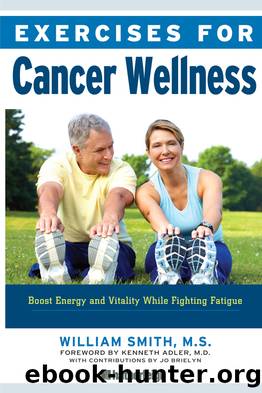Exercises for Cancer Wellness by William Smith

Author:William Smith [Smith, William]
Language: eng
Format: epub
ISBN: 978-1-57826-572-5
Publisher: Hatherleigh Press
Published: 2017-01-24T00:00:00+00:00
Important Assessments
Medical Tests
Medical tests, including blood panels, neurological/reflexive tests, updated family history, and stress tests are tests that your medical provider can provide based upon their clinical assessment of your health and risk profile. Maintain an open dialogue with your medical practitioner, particularly if you or your family has a history of heart problems.
Fitness Tests (Functional and Physical Assessments)
Functional Assessment: The Functional Assessment will provide you with a direct measurement of how you can improve in your daily activities. This includes walking stairs, getting in and out of chairs, etc. Refer to Chapter 5, this page for the Functional Assessment.
Physical Assessment: The Physical Assessment will provide you with a direct measurement of the improvements you can make in gaining strength as a result of following the exercises in this book. Refer to Chapter 5, this page for the Physical Assessment.
Waist Size: To determine your waist-to-height ratio, simply divide your waist size by your height (in inches). A waist-to-height ratio under 50 percent is generally considered healthy.
Stamina: The average person should be able to walk up a flight of stairs or walk once around an outdoor track without becoming out of breath.
12-Minute Walking Test: Find a measured distance, such as a track, and see how much distance you can cover in 12 minutes. (You can complete this on a treadmill, too.) Make sure you challenge yourself, while still being able to carry on intermittent conversation with a partner (see the Talk Test on this page).
Refer to the Rate of Perceived Exertion (RPE) scale on this page. You should aim to work at around 5â6 during the first two or three repetitions of this test. Thereafter, challenge yourself to reach a 7â8 on the RPE scale. This test is also known as the Cooper Test.
Quarter-Mile Timed Test: Find a measured 400-meter or quarter-mile track. See how long it takes you to cover the specified distance. Aim to work at a 6â7 on the Rate of Perceived Exertion (RPE) scale.
Strength: As you perform Strength Circuits (see this page), make note of any improvements you have made. For instance, are you able to perform more reps? Have you continued on from beginner to intermediate exercises?
Flexibility: Because levels of flexibility can differ greatly from one individual to the next, it is impossible to provide an average measurement of flexibility. Instead, you should aim to determine what improvements you are seeing in your Physical Assessment (see this page) from week to week. This will help you gauge whether you are improving your flexibility (based on your bodyâs abilities).
Re-Assessment: Perform the Functional Assessment and Physical Assessment again and compare your new results with your original results to determine how much you have improved in your overall strength and function.
Download
This site does not store any files on its server. We only index and link to content provided by other sites. Please contact the content providers to delete copyright contents if any and email us, we'll remove relevant links or contents immediately.
| Bone Cancer | Brain Cancer |
| Breast Cancer | Colorectal |
| Leukemia | Lung Cancer |
| Lymphatic | Prostate Disease |
| Skin Cancer |
Men In Love by Nancy Friday(4342)
Everything Happens for a Reason by Kate Bowler(4076)
The Immortal Life of Henrietta Lacks by Rebecca Skloot(3834)
Why We Sleep by Matthew Walker(3782)
The Sports Rules Book by Human Kinetics(3597)
Not a Diet Book by James Smith(2744)
The Emperor of All Maladies: A Biography of Cancer by Siddhartha Mukherjee(2440)
Sapiens and Homo Deus by Yuval Noah Harari(2424)
Day by Elie Wiesel(2251)
Endless Forms Most Beautiful by Sean B. Carroll(2089)
Angels in America by Tony Kushner(2054)
A Burst of Light by Audre Lorde(1984)
Hashimoto's Protocol by Izabella Wentz PharmD(1904)
Dirty Genes by Ben Lynch(1863)
Reservoir 13 by Jon McGregor(1860)
Stretching to Stay Young by Jessica Matthews(1719)
Fat for Fuel by Joseph Mercola(1701)
The Immune System Recovery Plan by Susan Blum(1701)
Boost Your Brain Power in 60 Seconds by Michelle Schoffro Cook(1681)
